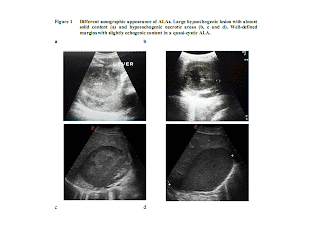DISCUSSION
Androgen-secreting ovarian tumors represent about 1% of all
ovarian neoplasms. Steroid cell
tumors (SCT) are among
the less common variants, which account for less than 0.1% of all
ovarian tumors.
1,2 The SCTs are
tumors composed of cells that resemble steroid hormone-secreting cells. The three major categories of SCTs are
stromal luteoma, Leydig cell tumors
that lack Sertoli cell or stromal
component, and steroid cell tumor not otherwise specified (NOS).3,4
In a review of 105 steroid cell tumors of the ovary, stromal luteomas account for about 22% of cases.5 These benign
functional neoplasms, first described by Scully in 1964, are believed to be of
stromal derivation, originating from luteinized cells or their precursors, or undifferentiated spindle cells of the ovarian stroma.6 About
60% of cases present with estrogenic manifestations, and only 12% of cases are androgenic.1,2 They are usually encountered in
postmenopausal women, typically during
workup for abnormal bleeding or for virilizing/feminizing symptoms.2,6 Occasionally, they may occur
as unsuspected findings during surgery.7
Some reported estrogenic manifestations include endometrial hyperplasia
and well-differentiated endometrioid adenocarcinoma.2
A previously reported case
of an undifferentiated NOS steroid cell tumor presented with hirsutism,
amenorrhea, clitoromegaly, and temporal baldness.8 In our patient’s case, hirsutism was associated with
signs of virilization in the form of
deepening voice, clitoromegaly,
frontal baldness and increased muscularity.
In androgen-secreting ovarian tumors,
serum testosterone levels are often high, but DHEA-S levels are low. Our patient also had grossly elevated serum
testosterone but normal DHEA-S levels. The diagnosis of these rare tumors can be problematic, especially in the case of a small ovarian tumor. These tumors
are typically less than 3 cm in
diameter, which explains poor
visualization with ultrasonography
and computerized tomography.4 In previous case reports, selective venous
sampling have been shown to be highly effective
in tumor localization.9 However, this
is an invasive and operator-dependent procedure with the risk of hemorrhage. A
few case reports have previously described gonadotropin-dependent stromal luteoma, but these tumors could
not be localized with imaging techniques. Testosterone, FSH and LH were
markedly inhibited following the administration of a GnRH analogue, suggesting
a gonadotropin-dependent, testosterone-secreting ovarian tumor; and implying that a stromal luteoma is not autonomous but is gonadotropin-dependent.10 In our case, computerized tomography incidentally detected a left adnexal mass, which was not clinically palpable; and was
subsequently confirmed by transvaginal
ultrasonography. A different kind of luteoma can appear in pregnancy. In the
Philippines, one case of a maternal pregnancy luteoma responsible for
virilization of both newborn and mother was
reported, which was not the case in this patient.12
Microscopically, stromal luteomas are composed of round polyhedral
cells present in nests that form nodules. Crystalloids of Reinke are
conspicuously absent, a distinguishing
feature of stromal luteomas from Leydig cell tumors.2 In difficult cases,
immunocytochemistry provides diagnostic accuracy. The most useful immunohistochemical marker
for their identification is alpha-inhibin, which is positive in most neoplasms
in the sex cord-stromal group.4 Stromal hyperthecosis has been found in
association with stromal luteomas in the surrounding or contralateral ovary in 90% of cases, a feature not seen in our patient.2,12
In the evaluation of postmenopausal androgen excess, the history
and physical examination direct the appropriate laboratory and radiologic
evaluation. Testosterone and DHEA-S are the primary hormonal tests that should be measured.13 A
testosterone level above
200 ng/dL or DHEA-S level more
than 800
ng/mL suggest the need to evaluate
for a tumor of the ovary or adrenal. In a study of 478 women (both
premenopausal and post-menopausal) with signs and symptoms of hyperandrogenism,
11 had testosterone level above 250 ng/dL. However, only one of these
11 had a
tumor. Of the 10 women with
DHEA-S level above 600 ng/mL, none had
an adrenal tumor.14
Several reports have
also more recently confirmed that absolute levels of elevation
of these steroid hormones do not
clearly differentiate the etiologies. Some have suggested a 2- to 5-day
low dose dexamethasone suppression
test. Failure to suppress baseline
elevation of testosterone or DHEA-S is thought
to indicate an ovarian source.15 However,
this approach has not been studied among the postmenopausal women.
Pelvic ultrasonography
or magnetic resonance imaging (MRI) is useful in women with elevated
testosterone levels to evaluate the ovary. The expertise of the ultrasonographer
may influence detection, as most tumors are quite small. A CT or MRI of the
adrenals is indicated in the evaluation of patients with high DHEA-S, or signs and symptoms
and laboratory abnormalities suggestive of adrenal Cushing’s syndrome. Although most patients with isolated
elevation of testosterone have an
ovarian source of hyperandrogenism, there are rare case reposts of testosterone-secreting
adrenal adenomas.16 Thus, imaging the adrenals is useful before proceeding to
ovarian surgery.
Data is limited concerning the frequency and severity
of androgen excess in the menopause. No
data is available concerning long-term
effects of altering androgen levels. However,
high androgens adversely alter lipid profile with increase LDL, decrease in HDL
and increase triglyceride levels.17,18 There
have been recent associations reported between levels of advance glycation end-products
and testosterone levels in post-menopausal women, independent of insulin
resistance. High testosterone and
estrogen are both associated with worsening insulin resistance and can worsen hypertension and
fluid retention. Recent studies have shown that high testosterone in women correlate with increased risk for breast
cancer and cardiac risk.
18,19 In a group of
390 postmenopausal women, 104 of
these with history of irregular cycles
and hyperandrogenemia had more evidence of coronary artery disease by angiogram, as well as
more obesity, metabolic syndrome and diabetes.18,20 This emphasizes the need for thorough evaluation and treatment
in postmenopausal women who present with hyperandrogenism. An interdisciplinary approach to management
is strongly recommended.
CONCLUSION
This case highlights the importance of a thorough evaluation
in postmenopausal women who present with virilization and
hyperandrogenism. The physical manifestations of androgen excess
also portend the serious health risks associated with this condition.The cardiometabolic
consequences of hyperandrogenemia, particularly due to underlying insulin resistance, leading to diabetes, dyslipidemia and
worsening hypertension, should also be evaluated and treated.







































